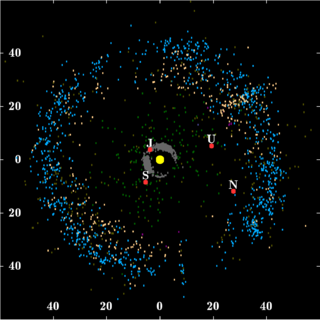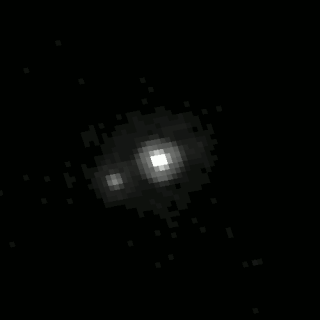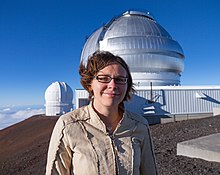
The Kuiper belt is a circumstellar disc in the outer Solar System, extending from the orbit of Neptune at 30 astronomical units (AU) to approximately 50 AU from the Sun. It is similar to the asteroid belt, but is far larger—20 times as wide and 20–200 times as massive. Like the asteroid belt, it consists mainly of small bodies or remnants from when the Solar System formed. While many asteroids are composed primarily of rock and metal, most Kuiper belt objects are composed largely of frozen volatiles, such as methane, ammonia, and water. The Kuiper belt is home to most of the objects that astronomers generally accept as dwarf planets: Orcus, Pluto, Haumea, Quaoar, and Makemake. Some of the Solar System's moons, such as Neptune's Triton and Saturn's Phoebe, may have originated in the region.

Following the discovery of the planet Neptune in 1846, there was considerable speculation that another planet might exist beyond its orbit. The search began in the mid-19th century and continued at the start of the 20th with Percival Lowell's quest for Planet X. Lowell proposed the Planet X hypothesis to explain apparent discrepancies in the orbits of the giant planets, particularly Uranus and Neptune, speculating that the gravity of a large unseen ninth planet could have perturbed Uranus enough to account for the irregularities.

A trans-Neptunian object (TNO), also written transneptunian object, is any minor planet in the Solar System that orbits the Sun at a greater average distance than Neptune, which has an orbital semi-major axis of 30.1 astronomical units (au).

A minor-planet moon is an astronomical object that orbits a minor planet as its natural satellite. As of January 2022, there are 457 minor planets known or suspected to have moons. Discoveries of minor-planet moons are important because the determination of their orbits provides estimates on the mass and density of the primary, allowing insights into their physical properties that are generally not otherwise accessible.

28978 Ixion (, provisional designation 2001 KX76) is a large trans-Neptunian object and a possible dwarf planet. It is located in the Kuiper belt, a region of icy objects orbiting beyond Neptune in the outer Solar System. Ixion is classified as a plutino, a dynamical class of objects in a 2:3 orbital resonance with Neptune. It was discovered in May 2001 by astronomers of the Deep Ecliptic Survey at the Cerro Tololo Inter-American Observatory, and was announced in July 2001. The object is named after the Greek mythological figure Ixion, who was a king of the Lapiths.

Orcus is a large trans-Neptunian object with a large moon, Vanth. It has a diameter of 870 to 960 km, the size of or somewhat smaller than the Inner Solar System dwarf planet Ceres. Orcus is generally accepted by astronomers as a dwarf planet, although there is some doubt. The surface of Orcus is relatively bright with albedo reaching 23 percent, neutral in color and rich in water ice. The ice is predominantly in crystalline form, which may be related to past cryovolcanic activity. Other compounds like methane or ammonia may also be present on its surface. Orcus was discovered by American astronomers Michael Brown, Chad Trujillo, and David Rabinowitz on 17 February 2004.

Sedna is a dwarf planet in the outermost reaches of the inner Solar System, orbiting the Sun beyond the orbit of Neptune. Discovered in 2003, the planetoid's surface is one of the reddest known among Solar System bodies. Spectroscopy has revealed Sedna's surface to be mostly a mixture of the solid ices of water, methane, and nitrogen, along with widespread deposits of reddish-colored tholins, a chemical makeup similar to those of some other trans-Neptunian objects. Within range of uncertainties, it is tied with the dwarf planet Ceres in the asteroid belt as the largest planetoid not known to have a moon. Its diameter is roughly 1,000 km. Owing to its lack of known moons, the Keplerian laws of planetary motion cannot be employed for determining its mass, and the precise figure as yet remains unknown.

Michael E. Brown is an American astronomer, who has been professor of planetary astronomy at the California Institute of Technology (Caltech) since 2003. His team has discovered many trans-Neptunian objects (TNOs), including the dwarf planet Eris, which was originally thought to be bigger than Pluto, triggering a debate on the definition of a planet.

Abraham "Avi" Loeb is an Israeli-American theoretical physicist who works on astrophysics and cosmology. Loeb is the Frank B. Baird Jr. Professor of Science at Harvard University, where since 2007 he has been Director of the Institute for Theory and Computation at the Center for Astrophysics. He chaired the Department of Astronomy from 2011–2020, and founded the Black Hole Initiative in 2016.

A dwarf planet is a small planetary-mass object that is in direct orbit around the Sun, massive enough to be gravitationally rounded, but insufficient to achieve orbital dominance like the eight classical planets of the Solar System. The prototypical dwarf planet is Pluto, which was regarded as a planet before the "dwarf" concept was adopted in 2006.

A small Solar System body (SSSB) is an object in the Solar System that is neither a planet, a dwarf planet, nor a natural satellite. The term was first defined in 2006 by the International Astronomical Union (IAU) as follows: "All other objects, except satellites, orbiting the Sun shall be referred to collectively as 'Small Solar System Bodies' ".

An interstellar object is an astronomical object in interstellar space that is not gravitationally bound to a star. This term can also be applied to an object that is on an interstellar trajectory but is temporarily passing close to a star, such as certain asteroids and comets. In the latter case, the object may be called an interstellar interloper.

An extreme trans-Neptunian object (ETNO) is a trans-Neptunian object orbiting the Sun well beyond Neptune (30 AU) in the outermost region of the Solar System. An ETNO has a large semi-major axis of at least 150–250 AU. Its orbit is much less affected by the known giant planets than all other known trans-Neptunian objects. They may, however, be influenced by gravitational interactions with a hypothetical Planet Nine, shepherding these objects into similar types of orbits. The known ETNOs exhibit a highly statistically significant asymmetry between the distributions of object pairs with small ascending and descending nodal distances that might be indicative of a response to external perturbations.

2013 SY99, also known by its OSSOS survey designation uo3L91, is a trans-Neptunian object discovered on September 29, 2013 by the Outer Solar System Origins Survey using the Canada–France–Hawaii Telescope at Mauna Kea Observatory. This object orbits the Sun between 50 and 1,300 AU (7.5 and 190 billion km), and has a barycentric orbital period of nearly 20,000 years. It has the fourth largest semi-major axis for an orbit with perihelion beyond 38 AU. 2013 SY99 has one of highest perihelia of any known extreme trans-Neptunian object, behind sednoids including Sedna (76 AU), 2012 VP113 (80 AU), and Leleākūhonua (65 AU).

(523794) 2015 RR245, provisional designation 2015 RR245, is a large trans-Neptunian object of the Kuiper belt in the outermost regions of the Solar System. It was discovered on 9 September 2015, by the Outer Solar System Origins Survey at Mauna Kea Observatories on the Big island of Hawaii, in the United States. The object is in a rare 2:9 resonance with Neptune and measures approximately 600 kilometers in diameter. 2015 RR245 was suspected to have a satellite according to a study announced by Noyelles et al. in a European Planetary Science Congress meeting in 2019.

Megan E. Schwamb is an American astronomer and planetary scientist, and lecturer at Queen's University, Belfast. Schwamb has discovered and co-discovered several trans-Neptunian objects, and is involved with Citizen science projects such as Planet Four and Planet Hunters.
The Outer Solar System Origins Survey (OSSOS) is an astronomical survey and observing program aimed at discovering and tracking trans-Neptunian objects located in the outermost regions of the Solar System beyond the orbit of Neptune. OSSOS is designed in way that observational biases can be characterized, allowing the numbers and orbits of detected objects to be compared using a survey simulator to the populations predicted in dynamical simulations of the emplacement of trans-Neptunian objects. Conducted at the Canada-France-Hawaii telescope at Mauna Kea Observatories in Hawaii, the survey has discovered 39 numbered objects as of 2018, with potentially hundreds more to follow. The survey's first numbered discovery was the object (496315) 2013 GP136 in 2013.

ʻOumuamua is the first interstellar object detected passing through the Solar System. Formally designated 1I/2017 U1, it was discovered by Robert Weryk using the Pan-STARRS telescope at Haleakalā Observatory, Hawaii, on 19 October 2017, approximately 40 days after it passed its closest point to the Sun on 9 September. When it was first observed, it was about 33 million km from Earth and already heading away from the Sun.
(505448) 2013 SA100, provisional designation 2013 SA100 and also known as o3l79, is a trans-Neptunian object from the classical Kuiper belt in the outermost region of the Solar System. It was discovered on 5 August 2013, by astronomer with the Outer Solar System Origins Survey at the Mauna Kea Observatories, Hawaii, in the United States. The classical Kuiper belt object belongs to the hot population and is a weak dwarf planet candidate, approximately 260 kilometers (160 miles) in diameter.

2I/Borisov, originally designated C/2019 Q4 (Borisov), is the first observed rogue comet and the second observed interstellar interloper after ʻOumuamua. It was discovered by the Crimean amateur astronomer and telescope maker Gennadiy Borisov on 29 August 2019 UTC.


















